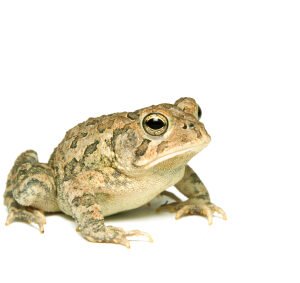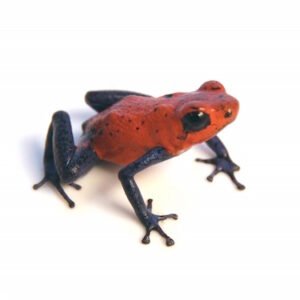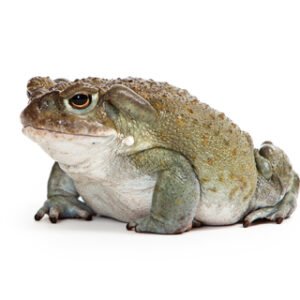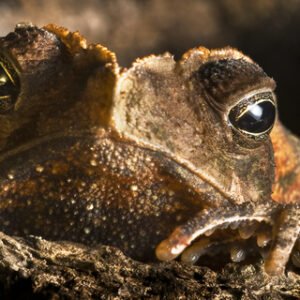The Goliath Frog: Nature’s Giant Amphibian
Introduction to the Goliath Frog
The Goliath Frog (Conraua goliath) holds the title of the largest frog species on Earth, an extraordinary distinction in the realm of amphibians. First discovered in the late 19th century, this giant amphibian is native to the rainforests of West Africa, particularly in Cameroon and Equatorial Guinea. The species was aptly named after the biblical figure Goliath, symbolizing its remarkable size, with adult individuals weighing up to 3.3 kilograms (approximately 7.3 pounds) and measuring up to 32 centimeters (about 12.6 inches) in length.
In terms of physical characteristics, the Goliath Frog possesses a robust body structure characterized by powerful hind limbs, which facilitate impressive jumping abilities, essential for its survival in a multifaceted environment. Its smooth skin ranges in color from a mottled green to dark brown, enabling effective camouflage amid the foliage of its rainforest habitat. The Goliath Frog’s distinct features include large, bulging eyes that enhance nocturnal vision and a wide mouth that allows it to consume a diverse diet, primarily consisting of insects, small mammals, and even other frogs.
This remarkable species plays a critical role in its ecosystem, acting as both predator and prey. Understanding the ecological significance of the Goliath Frog offers valuable insights into biodiversity and the health of rainforest ecosystems. As an amphibian, it serves as an indicator of environmental conditions, and its decline signals potential habitat loss or ecological disturbances. The Goliath Frog exemplifies the majestic diversity of amphibians and raises awareness about the importance of conserving their natural habitats and ensuring their survival in the face of various threats, including habitat destruction and climate change.
Physical Characteristics and Behavior
The Goliath Frog (Conraua goliath) is renowned for being the largest amphibian on Earth, a title earned due to its impressive size and distinctive physical traits. Adult Goliath Frogs can weigh up to 3.3 kilograms (approximately 7.3 pounds) and measure about 32 centimeters (around 12.6 inches) in length, making them significantly larger than most frog species. Their robust bodies feature a greenish-brown coloration with darker mottling, which serves as effective camouflage against predators in their natural habitat. The pigmentation allows these giant frogs to blend seamlessly within the shadows of their dense rainforest environments, providing them with essential protection.
In terms of behavior, Goliath Frogs primarily inhabit freshwater ecosystems, including rivers and swamps in West and Central Africa. Their diet is quite diverse, as they are carnivorous and will consume a variety of prey. Goliath Frogs mainly feed on insects, small mammals, and even smaller amphibians, utilizing their strong, muscular legs to capture food with swift movements. This predatory behavior showcases their adaptability and effectiveness as hunters within their ecological niche.
Mating rituals of the Goliath Frog are also fascinating. Breeding typically occurs during the rainy season, with males using their vocalizations to attract females. These vocal calls reverberate through their habitat, announcing their presence in search of a mate. Once paired, the female deposits her eggs in aquatic environments, where the tadpoles will develop into juvenile frogs. The Goliath Frog’s lengthy life cycle further distinguishes them, as they exhibit slower growth rates compared to other frog species. Overall, these aspects of physical characteristics and behavior underline the Goliath Frog’s unique position within the amphibia class, setting them apart from their smaller counterparts.
Conservation Status and Threats
The Goliath Frog (Conraua goliath), known as the largest frog in the world, faces significant conservation challenges. Currently, this remarkable amphibian is classified as “Vulnerable” by the International Union for Conservation of Nature (IUCN). This designation reflects a concerning decline in its population, driven by several interconnected threats. One of the primary concerns affecting Goliath Frog populations is habitat loss. Their natural environments, primarily tropical rainforests and river systems in Central and West Africa, are increasingly fragmented or destroyed due to agricultural expansion, logging, and infrastructure development.
Climate change also poses a serious risk to the Goliath Frog’s survival. Alterations in temperature and precipitation patterns can lead to changes in breeding habitats, affecting their reproductive success and survival rates. Furthermore, the Goliath Frog’s dependence on specific aquatic environments makes it particularly vulnerable to droughts and shifting weather patterns. The loss of suitable habitats not only reduces their nesting sites but also exposes them to predators and other threats.
Another significant factor threatening this species is hunting. Local communities often turn to these enormous amphibians for food, leading to unsustainable harvest levels. The demand for Goliath Frogs in the pet trade and for traditional medicine has compounded the pressure on their populations. These practices not only contribute to their decline but can also disrupt local ecosystems where these frogs play vital roles as both prey and predator.
Conservation efforts are underway to address these threats. Organizations are working to promote sustainable land-use practices, protect critical habitats, and raise awareness about the importance of preserving the Goliath Frog. By continuing to support conservation initiatives, it is possible to ensure the survival of this extraordinary species for future generations.
Cultural Significance and Fascination
The Goliath frog (Conraua goliath), recognized as the largest amphibian on Earth, has captivated human imagination across various cultures. This remarkable species, native to the rainforests of Central Africa, is often shrouded in local folklore, where it is attributed mystical properties. In some communities, the frog is seen as a symbol of strength and survival due to its impressive size and resilience in the face of habitat loss. Stories and legends surrounding the Goliath frog serve not only to entertain but also to impart lessons about nature and environmental stewardship. These narratives help to cultivate a connection between local populations and their natural environment, fostering a sense of responsibility for conservation efforts.
Moreover, the Goliath frog has made notable appearances in various media, from documentaries to children’s books, thereby reaching a wider audience. Its portrayal as a creature of fascination often emphasizes its unique physical attributes and impressive leaping abilities, igniting curiosity among viewers. As educational content increasingly incorporates this iconic amphibian, it enhances public understanding of biodiversity and the ecological roles of frogs in their habitats.
Scientific researchers have also played a crucial role in elevating the profile of the Goliath frog. Their studies on the species’ behavior, reproductive habits, and ecological significance contribute to a broader understanding of amphibian biology. This ongoing research not only enriches academic discourse but also highlights urgent conservation needs in the face of threats like deforestation and climate change. Programs aimed at educating the public about the Goliath frog’s plight have become essential tools in promoting awareness and action. By engaging communities, schools, and nature enthusiasts, these initiatives foster a collective commitment to safeguarding this magnificent amphibian and its habitat for future generations.





